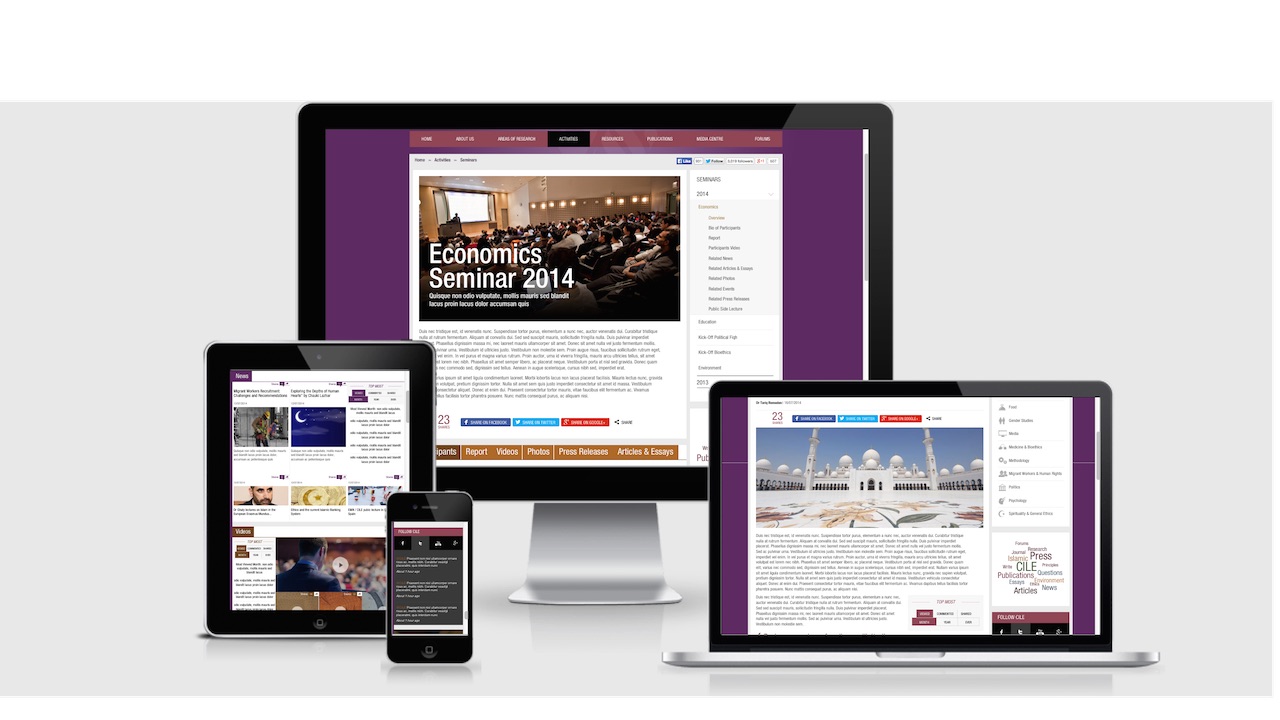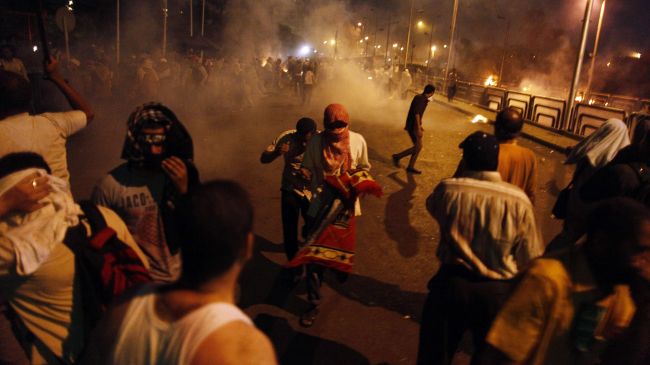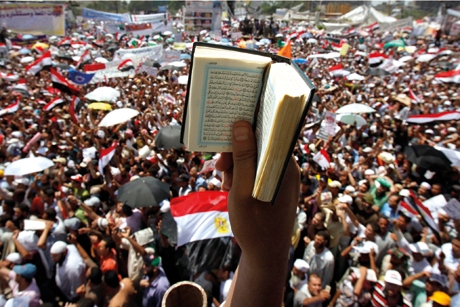Ramadan shows that to be a true Muslim is a lifelong intellectual challenge, not a single act of obedience
Tariq Ramadan
THE MESSENGER
The meanings of the life of Muhammad
256pp. Allen Lane. £20.
978 0 7139 9960 0
Read this book, but be careful to read it with an alert awareness of its subtitle. It is an act of piety, a beautifully articulated sermon that selects incidents from the life of the Prophet that can inspire the conduct of modern Muslims. It blends textual criticism with a lively appreciation of contemporary concepts and other faith traditions, while remaining grounded on an absolute bedrock of belief. The result is that, while some incidents are deconstructed to reveal inspiring early role models for Islamic democracy, spiritual self-sufficiency, ecology and women’s rights, the Angel Gabriel also makes frequent quite matter-of-fact appearances as the ambassador-messenger of God.
The Messenger cannot be considered an impartial historical biography in the Western tradition – still less an apology. Indeed, those familiar with the habitual points of Western interest in early Islam (which pretty much follows the tabloid code of sex and violence) will find Tariq Ramadan’s book a most frustrating document. Where are the pages devoted to the Prophet’s marriage to his child-bride, Aisha, or on his exemption from the limit of four wives placed on other believers, or on how the Prophet’s adopted son, Zayd, divorced his own wife, Zaynab, so that she could also join the household of Muhammad? There are similar blank spaces around many of the bloody military encounters, assassinations and executions that occurred during the lifetime of the Prophet.
But this is to sidestep the purpose of Ramadan’s book, which is to find “Meanings” from the life of the Prophet, to uplift, challenge and inspire modern Muslims. Judged within those premisses, the author has succeeded in creating an elegant, inspiring account, full of learning and challenging inquiry, that is worthy of multiple readings. Nor does he lose sight of the animating purpose of true religion, to charge mankind with love and compassion, and subdue the brutal realities of the competitive hunger which we all share. In Ramadan’s words, the objective of jihad (the spiritual struggle of a Muslim) lies in “resisting the dark temptations of the inner self”. Ramadan also cautions his reader with the declaration that “deeply, simply, he who cannot love cannot understand [religion]”.
His account of the boyhood of Muhammad is a fine example of his style. For he concentrates not just on the orphan’s sense of familial loss and exclusion from the urban society of Mecca, but on the positive gifts that came through his desert upbringing: how the shepherd boy was removed from the hypocritical obedience of formal religious practice, how his mind remained unfettered by rote learning, and his individuality unblemished by schooling; how his formative first years in the desert strengthened his self-sufficiency, how he faced the everyday facts of life, creativity and death unshielded by cosy domesticity; how his freedom from books gave him a delight in the power of the spoken word and in the oral traditions of the desert. Quite aside from the conventional Muslim belief in an angel-dictated Koran (to which Ramadan wholeheartedly subscribes), Muhammad is acknowledged to be a master of spoken Arabic. For, side by side with the Holy Book, there are the multi-volume collections of his sayings, which form an additional platform of inspiration to Muslims, with short, apparently simple phrases that are full of multiple readings, such as “Be in this world as if you were a stranger or a wayfarer” and “God is closer to you than your jugular vein”.
Ramadan is also pragmatic enough to re-examine conventional assessments of the Prophet’s marriage to his first wife, Khadijah, who is always depicted as a forty-year-old heiress. Using an alternative historical source and the fact that Khadijah bore six children after her marriage to Muhammad, Ramadan convincingly suggests that she was a twice widowed twenty-eight-year-old. Richer, older and more experienced than Muhammad she certainly was, but possibly only three years separated her in age from the twenty-five-year-old caravan merchant she wooed. This might be considered a mere footnote detail, but for the fact that whole studies have been built around that age difference (even such masterly surveys as Professor Maxime Rodinson’s biography of the Prophet indulge in imaginative interpretations of the psychological frustrations of Muhammad’s early married life).
In his assessment of the Prophet’s mystical Night Journey (in which he flew to Jerusalem, and from there to heaven), Ramadan is circumspect: “Muslim scholars have, from the outset, pondered the question of a purely spiritual nature or whether it was also physical”. Here he might be seen to be a fence-sitter, but for his detailed quotation of the three koranic verses that refer to the journey. For the tradition of dissenting views can be seen to have even entered into the text of the Koran: “Will you dispute with him concerning what he saw?”. In his account of the Hejira – the migration of the Muslim community from the persecution of Mecca to the freedom of the oasis of Medina – Ramadan is able to address the true audience for his book: the Muslim communities now resident in Europe and America. He explains that the Hejira (just like the twentieth-century journeys of many Muslim families) was no accident, but a cautious and well-planned event. It was a rational decision for the faithful to break away from their tormentors and march to freedom; a decision such as many Afghans, Egyptians, Saudis and Iraqis have been forced to take over the past hundred years. Muhammad took two years over it, carefully discharging all the debts he owed to non-Muslims in the process.
He honoured the different traditions of Medina, his new home, just as Muslim migrants must do today. Like the Prophet, they can also use the act of migration as a spiritual tool, to help shed mere national or tribal customs in order to define what is truly and inherently Islamic. Ramadan is also careful to remind his readers that the Prophet only came to the oasis of Medina as part of a carefully agreed legal contract with the existing inhabitants. This contract, developed over two separate series of negotiations, did not demand the conversion of the natives, but merely bound all the inhabitants to help defend the oasis against outside aggressors.
This contract would be honoured and respected throughout the lifetime of the Prophet. Although he might be the unquestioned leader of the Muslim exiles from Mecca, he never did more than request the assistance of the men of Medina when setting out on campaign. It is good that modern Muslims should be reminded of this, and of how the period of persecution in Mecca helped unite their community of a few hundred souls, while the freedom of Medina helped breed conflicts and schisms as the community expanded into tens of thousands in just ten years.
Ramadan also reminds his readers that, if Medina is to be cited as a pattern of the perfect Muslim state, Muslims must also embrace other aspects from the lifetime of the Prophet: the freedom of women to speak out, to pray, study and learn, and that their leaders should follow his example and consult the people about the conduct of affairs. Other instances from the Prophet’s life are unlikely to be followed either today or tomorrow, such as the time when he permitted a delegation of visiting Christians (whom he had failed to convert) to pray in the central mosque of Medina. Nor do the modern leaders of Islam cherish the poor (the people of the bench) in anything like the manner of the Prophet – whose natural humility dictated that he continued to sew his own clothes and repair his own shoes until his dying day.
But that is the great worth of The Messenger. To be a true Muslim is a lifelong intellectual challenge, not a single act of obedience.
Barnaby Rogerson’s recent works include The Prophet Muhammad: A biography, 2003, and The Heirs of the Prophet Muhammad: And the roots of the Sunni–Shia Schism, 2007.
Source : TIMES ONLINE










Barnaby Rogerson’s article invites the reader approaching this book to be “careful to read it with an alert awareness of its subtitle”, that is, “The meanings of the life of Muhammad”.
In fact, the book of Tariq Ramadan, dedicated to the Life of the Prophet of Islam, by accompanying the reader through the Life of Muhammad, introduces him/her into a “space” dense with meanings where the “living” experience of the « Encounter with the Sacred » is made real and possible yesterday as today.
In this sense the author offers a key that will introduce the reader, both Muslim and non Muslim, into the Universe of Reference of Islam, by disclosing all the beauty and richness of its Message.
In particular, this book tells us a story with tones inviting to imagine the voyages, the desert, the places … places of the memory and … of the heart.
The reader answering to this invitation by letting those images take shape into his/her own conscience, will be able to receive the Message that this book so profoundly conveys, becoming he himself/she herself, the privileged witness of the living Dialogue between God and the creature, encompassing time and space …
In this sense the reader is definitely offered the possibility of experiencing the profound liberty of his own heart at receiving the richness of the spiritual dimension of Islam as an universal, inner dimension susceptible of being continually enriched and more profoundly explored …
In this sense too, the book is powerfully evocative: evocative of Meanings, coming to life through the righteous life of the Prophet of Islam, that calls the believer to experience the most profound dimension of the Faith. His struggles, his choices, his humbleness, his profound sense of justice and his devotion to the Creator, clearly show the Way of a man through his humanity, who was able to accept trials and difficulties with faith and confidence in God …
As a result, the Way to God shapes through the conscience of the believer into the intimate and profound “relationship of reciprocity” between the Creator and the creature.
This unique relationship is comparable to a seed needing to be nurtured with care and love to the point of becoming a constant and meaningful dialogue, accompanying … What the reader comes to witness, in other words, is the Guidance of God through a life of faith and struggle called to become living experience and, as such, Awareness of His Proximity “here and now”.
The attentive reading of this book leaves the reader with a hope for himself/herself and with concrete and beautiful indications that make of the Faith a substantial question of Experience … through endurance in the faith, Education to concreteness and justice, as the sole responsible and, as such, acceptable approaches to life.
There is also the sense of a profound confidence in God’s help that makes of human intrinsic fragility a possibility offered to the creature to experience His Grace and Piety through his/her own life …
The Message of Muhammad is shaping through His own entire Life as told us by Tariq Ramadan in these pages of profound inspiration. The life of the Prophet of Islam becomes, as such, an invitation to enter the faith of our own hearts, with a new courage that calls to root our faith both as Muslims and as non Muslims into life experience.
In other words It is about the Intelligence of a Faith calling the Sacred to convey Its answers in everyday life yesterday as today, making of the Heart the elective place of the Encounter …
No doubt that Islam is an Universal message! The need of a mature and aware reading of Islam through a subtle and profoundly intelligent approach, is what this book shows and what makes it so attractive to both Muslims and non Muslims willing to encounter the Sacred into Its marvellous Ways, into its Universal Values and richness of Meanings that never stop to enchant the heart who knows the beauty of the sincere prayer and that, through it, has learned to trust the Unique …